Advisory Board
Geneviève Baudoin
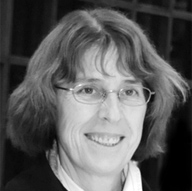 Geneviève Baudoin received the Dipl.-Ing. degree in 1977 from the École Nationale Supérieure des Télécommunications de Paris (now Telecom ParisTech), and the HDR Habilitation for PHD direction from Université Marne La Vallée en 2000.She was lecturer at the university Paris-Ouest from 1977 to 1979; then she joined the Philips Research laboratory in France, as a research-engineer in the field of medical applications of ultrasounds.
Geneviève Baudoin received the Dipl.-Ing. degree in 1977 from the École Nationale Supérieure des Télécommunications de Paris (now Telecom ParisTech), and the HDR Habilitation for PHD direction from Université Marne La Vallée en 2000.She was lecturer at the university Paris-Ouest from 1977 to 1979; then she joined the Philips Research laboratory in France, as a research-engineer in the field of medical applications of ultrasounds.
Since November 1980, she has been with ESIEE Paris that is the CCIP's (Chambre de Commerce et d’Industrie de Paris) center for scientific and engineering education and research. She is Professor with the department of Telecommunications. She has been in charge of several pedagogical engineering programs in telecommunications and signal processing. For 10 years, she was chair of the telecommunications department. She is a member of the scientific board of Université Paris-Est. And since 2001, she is Research Director of ESIEE Paris.
Her research and teaching activities include wireless communications, digital signal processing and speech processing. She has been involved in low bit rate speech coding for many years. Then she moved to the design of auditory information systems for the mobility of blind people in urban environments with scientific focus on localization and nomadic systems. She is now working on wireless transceivers for mobile terminals including new transmitter architectures for high efficiency signal generation with good linearity and flexibility, ultra-wide band impulse radio, signal processing for correction of RF devices impairments, digital pre-distortion of power amplifiers. She has been involved in many international cooperation, partly while on temporary leave of her ESIEE position, for example: 3month invitation by Tektronix in Beaverton, USA to work on TV ghost cancelling and 9 months invitation in the telecommunication department of the technical University of Hamburg, Germany.
She is the author or co-author of several textbooks on digital radio-communications and digital signal processing and of a DSP Teaching Materials CD ROM. She is the author or co-author of numerous scientific papers on signal processing and radio-communications.
[1] JARDIN, P.; BAUDOIN, G. Filter lookup table method for power amplifier linearization. IEEE Transactions on Vehicular Technology, 2007, vol. 56, no. 3, p. 1076 to 1087.
[2] DIET, A.; BAUDOIN, G.; VILLEGAS, M. Influence of the EER/polar transmitter architecture on IQ impairments for an OFDM signal. International Review of Electrical Engineering (IREE), 2008, vol. 3, no. 2, p. 410-417. Praise Worthy Prize.
[3] MAALI, A.; MESLOUB, K.; DJEDDOU, M.; MIMOUN, H.; BAUDOIN, G.; OULDALI, A. Adaptive CA-CFAR threshold for non-coherent IR-UWB energy detector receivers. IEEE Communications Letters, 2009, vol. 13, no. 12, p. 959-961.
[4] SUAREZ PENALOZA, M.L.; VALENTA, V.; BAUDOIN, G.; VILLEGAS, M.; MARSALEK, R. Modified polar Sigma-Delta transmitter for multi-radio applications. Eurasip Journal on Wireless Communication and Networking, 2010, article ID 979120.
[5] BAUDOIN, G.; VILLEGAS, M.; SUAREZ PENALOZA, M.L.; DIET, A.; ROBERT, F. Performance analysis of multiradio transmitter with polar or cartesian architectures associated with high efficiency switched-mode power amplifiers. Radioengineering, 2010, vol. 19, no. 4, p. 470 to 478.
Yevgeni Koucheryavy
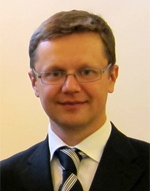 Yevgeni Koucheryavy is a Full Professor (January 2010) in the Department of Communications Engineering at the Tampere University of Technology, Finland. He received the M.Sc. degree (1997) from the State University of Telecommunications, St. Petersburg, Russia, and the PhD degree (2004) from the Tampere University of Technology, Tampere, Finland.
Yevgeni Koucheryavy is a Full Professor (January 2010) in the Department of Communications Engineering at the Tampere University of Technology, Finland. He received the M.Sc. degree (1997) from the State University of Telecommunications, St. Petersburg, Russia, and the PhD degree (2004) from the Tampere University of Technology, Tampere, Finland.
Prior joining the Tampere University of Technology, Yevgeni spent five years in industry with R&D LONIIS in St. Petersburg, Russia, where he held various technical and managerial positions. Sum of contracts supervised by him (1998 – 2000) was over USD $1 mln.
Yevgeni possesses teaching experience of more than 15 years, starting from 1996. Yevgeni has been teaching for different target groups, students (undergraduate and graduate) and professionals (invited talks or full day trainings and tutorials) in Austria, Brazil, Ireland, Russia, Sweden and Spain. He acted as a PhD evaluation committee member or examiner in several countries.
Yevgeni leads a research group on Advanced Networks (ANG) since 2003. In average, the group consists out of a Full Professor, 1 Assistant/Associate Professor, 1 – 2 postdoctoral researcher, 3 – 4 PhD students and 4 – 6 MSc students. The research studies resulted in over 100 publications in proceedings of peer reviewed conferences and over 15 in international journals; 1 paper won a “Best Paper” award. Since 2003 group’s members have received a number of grants and scholarships: 6 scholarships from Nokia Foundation, 4 from TISE (Tampere Graduate School in Information Science and Engineering), 3 from GETA (Graduate School in Electronics, Telecommunications and Automation), 6 from CIMO (Centre for International Mobility, Finland), 2 from Finnish Cultural Foundation. Within last 2 years (2010 – 2011) from the sources outside of TUT Yevgeni managed to attract over 1.5 mln Euros as a research funding.
Yevgeni actively participates in national and international research and development projects – in particular he chaired COST 290 "Wi-QoST: Traffic and QoS Management in Wireless Multimedia Networks" ran from 2004 to 2008; and currently he is chairing COST IC0906 “WiNeMO: Wireless Networking for Moving Objects” scheduled for 2010 – 2014. He has been working in a number of industrial projects with different companies including Nokia, Nokia Siemens Networks, Alcatel, Ericsson, Cisco, Siemens, etc. Currently Yevgeni together with representative from Ericsson leads a technological Work Package of the ambitious national Finnish project on Internet of Things with a budget over 20 mln euros (2012). He is an invited expert in ITU-T and Skolkovo Foundation and acts as an external reviewer for state funding agencies of several European countries.
Yevgeni has authored or co-authored over 100 papers in the field of advanced wired and wireless networking and communications. He co-edited several proceedings books published in LNCS, Springer. Yevgeni serves on TPC and Steering Committee of a number of international conferences and workshops; he also serves as an editor for several international journals. His current research interests include various aspects in heterogeneous wireless communications and systems, network and services performance evaluation, Internet of Things and standardization. Yevgeni is a Senior IEEE member.
Ioan E. Lager
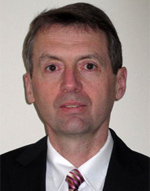 Ioan E. Lager has received his Engineer diploma from Transilvania University, Braşov, Romania, a PhD degree from Delft University of Technology (DUT), the Netherlands, and a second PhD degree from Transilvania University.
Ioan E. Lager has received his Engineer diploma from Transilvania University, Braşov, Romania, a PhD degree from Delft University of Technology (DUT), the Netherlands, and a second PhD degree from Transilvania University.
After graduation, he worked for a period of 3 years in industry, after which he joined Transilvania University. In 1993 he started a PhD programme with DUT. After successfully defending his thesis in 1996, he joined Schlumberger—Doll Research, Ridgefield, Connecticut, USA where he remained for one year as a Post-Doctoral Visiting Scientist. At the end of 1997 he returned to DUT with which he is affiliated ever since. He is currently Associated Professor with the Telecommunications Department of the Faculty of Electrical Engineering, Mathematics and Computer Science (EEMCS).
His initial scientific interests covered the domain of computational electromagnetics, with an emphasis on developing highly effective computational schemes on non-structured grids. The most important achievements in this period were the introduction, together with Dr. Gerrit Mur (formerly with DUT-EEMCS), of an original class of discretisation functions to be used in finite-element type schemes, the so-called “Generalised Chartesian Elements”, and the laying of the foundations, together with Professor Adrianus T. de Hoop (DUT-EEMS) of a domain-integrated space-time computational scheme. Starting 2002 he shifted his focus towards the domain of (array) antenna design, with contributions in the design and implementation of non-uniform array architectures and, more recently, in the emerging field of pulsed-field propagation. The most important array antenna achievements are circumscribed to the shared aperture antenna concept, employing non-uniform element placement and sub-array interleaving for implementing multi-functionality. In the pulsed-field propagation area he promoted, in collaboration with Professor de Hoop, a number of effective time-domain analysis instruments.
He authored 3 monographs, (co-)edited 2 collected works books, and (co-)authored more than 100 collected works books, journal or conference papers.
[1] M. Simeoni, I.E. Lager, C.I. Coman, and A.G. Roederer, “Implementation of polarization agility in planar phased-array antennas by means of interleaved sub-arrays,” Radio Science, vol. 44, RS5013, October 2009.
[2] I.E. Lager, C. Trampuz, M. Simeoni, and L.P. Ligthart, “Interleaved array antennas for FMCW radar applications,” IEEE Transactions on Antennas and Propagation, vol. 57, no. 8, pp. 2486-2490, August 2009.
[3] A.T. de Hoop, I.E. Lager, and V. Tomassetti, “The pulsed-field multiport antenna system reciprocity relation and its applications - A time-domain approach,” IEEE Transactions on Antennas and Propagation, vol. 57, no. 3, pp. 594-605, March 2009.
[4] I.E. Lager, E. Tonti, A.T. de Hoop, G. Mur, and M. Marrone, “Finite formulation and domain-integrated field relations in electromagnetics - a synthesis,” IEEE Transactions on Magnetics, vol. 39, no. 3, pp. 1199-1202, May 2003.
[5] I.E. Lager and G. Mur, “Application of the domain-integrated field relations method to the solution of large scale static and stationary magnetic field problems,” IEEE Transactions on Magnetics, vol. 38, no. 2, pp. 465-468, March 2002.
Erich Leitgeb
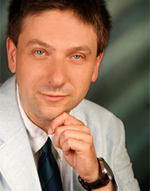 Erich Leitgeb born in 1964 in Fürstenfeld (Styria, Austria) received his master degree (Dipl.-Ing. in electrical engineering) at the Technical University of Graz in 1994. In 1994 he started research work in Optical Communications and RF at the Department of Communications and Wave Propagation (TU Graz). In February 1999 he received his PhD-degree (Dr. at the University of Technology Graz) with honours. End of 2003 (after profound knowledge and research experience in Optical Communications, Optical Wireless, Propagation and Microwaves), he submitted his relevant publications for review to become an Associate Professor. In spring 2008 he received the Professor position on Optical Communications at the University of Technology Graz.
Erich Leitgeb born in 1964 in Fürstenfeld (Styria, Austria) received his master degree (Dipl.-Ing. in electrical engineering) at the Technical University of Graz in 1994. In 1994 he started research work in Optical Communications and RF at the Department of Communications and Wave Propagation (TU Graz). In February 1999 he received his PhD-degree (Dr. at the University of Technology Graz) with honours. End of 2003 (after profound knowledge and research experience in Optical Communications, Optical Wireless, Propagation and Microwaves), he submitted his relevant publications for review to become an Associate Professor. In spring 2008 he received the Professor position on Optical Communications at the University of Technology Graz.
Since January 2000 he is project leader of international research projects in the field of optical communications and wireless communications (like COST 270 the EU project SatNEx (a NoE), SatNEx II, COST 291 and currently COST IC0802 and IC1101). He is leading the research group for Optical Communications (see research activities).
He is giving lectures in Optical Communications Engineering, Antennas and Wave Propagation and Microwaves. In 2002 he had a research stay at the department of Telecommunications at Zagreb University, Croatia. Additional research activities have been done in summer 2008 at the University of Ljubljana and the Josef Stefan Institute in Ljubljana, Slovenia. Since 2007 he is a Visiting Fellow (since 2009 a Guest Professor) at the Northumbria University in Newcastle and he had a few research stays in Newcastle in (spring and summer) 2007, in autumn 2009 and summer 2010. In the frame of the ERASMUS lecturer mobility he gave lectures in “Optical Wireless” in spring 2008 and 2009 at the Patras University in Greece and in autumn 2010 and 2011 at the Zagreb University in Croatia.
He is a Member of IEEE, SPIE, OSA and WCA. Since 2003 he is reviewer for IEEE and SPIE conferences and journals and he acts as member of Technical Committees and Chairpersons on these conferences. He was guest editor of a special issue (published 2006) in the Mediterranean Journal of Electronics and Communications on "Free Space Optics - RF" and later in two special issues on RFID and Near field Communications (published 2008 and 2009 in IEEE Transactions on Microwave Theory and Techniques). For 2008 he prepared the international IEEE conference CSNDSP 08 (July 2008) in Graz as local organizer. In the ConTEL 2011 together with the colleagues at FER Zagreb, he was acting as Technical Program Chair. Since 2010 he is a member of the Steering Committee of CSNDSP. Since 2011 he is also active in URSI Austria section.
Affiliation: The Department of Communications and Wave Propagation (founded in 1968 by Prof. W. Riedler), was splitted in 2004 in three smaller institutes, the Institute of Communications Networks and Satellite Communications (IKS), the Institute of Broadband Communication (IBK) and the Institute of Signal Processing and Speech Communications (SPSC). The Institute of Broadband Communication (IBK) focused on Wireless Technologies (including Free Space Optics (FSO), radar-techniques, microwaves and acoustics. Since 2010 a new institute the Institute of Microwaves and Photonics (IHF) was founded and the relevant topics on RF were moved from IBK to IHF.
Research Activities: The research group for Optical Communications and RF has high quality experience in Atmospheric Wave Propagation of RF and light (including attenuation, turbulences and atmospheric effects) and applications (including solutions of Free Space Optics in combination with other Communication technologies like Fiber, RF technology and Wireless LAN) for more than 15 years.
These areas are very well covered in teaching and research. As mentioned furthermore, scientific instruments for space applications are developed and were developed in the past. Close cooperation exists with Joanneum Research, the Space Research Institute of the Austrian Academy of Sciences and companies (like Infineon, NXP, EPCOS TDK etc.) around Graz. Additional activities are done within the institute with the Vienna Telecommunications Research Centre (FTW), the European Space Agency, the European Union, and in the past with the Russian Space Agency.
Markus Rupp
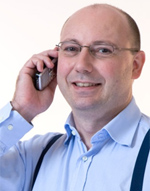 Markus Rupp received his Dipl.-Ing. degree in 1988 at the University of Saarbruecken, Germany and his Dr.-Ing. degree in 1993 at the Technische Universitaet Darmstadt, Germany, where he worked with Eberhardt Haensler on designing new algorithms for acoustical and electrical echo compensation.
Markus Rupp received his Dipl.-Ing. degree in 1988 at the University of Saarbruecken, Germany and his Dr.-Ing. degree in 1993 at the Technische Universitaet Darmstadt, Germany, where he worked with Eberhardt Haensler on designing new algorithms for acoustical and electrical echo compensation.
From November 1993 until July 1995, he had a postdoctoral position at the University of Santa Barbara, California with Sanjit Mitra where he worked with Ali H. Sayed on a robustness description of adaptive filters with impact on neural networks and active noise control. From October 1995 until August 2001 he was a member of Technical Staff in the Wireless Technology Research Department of Bell-Labs at Crawford Hill, NJ, where he worked on various topics related to adaptive equalization and rapid implementation for IS-136, 802.11 and UMTS.
Since October 2001 he is a full professor for Digital Signal Processing in Mobile Communications at the Vienna University of Technology where he founded the Christian-Doppler Laboratory for Design Methodology of Signal Processing Algorithms in 2002 at the Institute for Communications and RF Engineering. He served as Dean from 2005-2007.
He was associate editor of IEEE Transactions on Signal Processing from 2002-2005, is currently associate editor of JASP EURASIP Journal of Advances in Signal Processing, and JES EURASIP Journal on Embedded Systems. He is elected AdCom member of EURASIP since 2004 and served as president of EURASIP from 2009-2010.
He authored and co-authored more than 400 papers and patents on adaptive filtering, wireless communications, and rapid prototyping, as well as automatic design methods.
Awards:
Best Student Paper Award at Fourth International Conference on Mobile Computing and Multimedia (MoMM2006), Yogyakarta, Indonesia, with Luca Superiori and Olivia Nemethova.
EEEFCOM Innovationspreis 2008: "A Real-Time RFID Rapid Prototyping Environment for Multi Frequency-Band and Multi Standard Experiments" jointly with Robert Langwieser, Christoph Angerer, Michael Fischer, Gregor Lasser, Martin Holzer, Bastian Knerr, Lukas Mayer, Arpad Scholtz.
Unesco Award for fFORTE-WIT (Women in Technology), UN Dekadenprojekt 2009
Best Student Presentation Award of IEEE Forum SPRFS 2011, Robert Dallinger and Markus Rupp ''Adaptive digital pre-distortion based on two-block models''
Best Student Paper Award at VTC spring 2011, Budapest 15-18.5.2011.Michal Simko, Christian Mehlführer, Thomas Zemen and Markus Rupp, ''Inter-Carrier Interference Estimation in MIMO OFDM Systems with Arbitrary Pilot Structure''
[1] Markus Rupp, Ali H. Sayed, "A time-domain feedback analysis of filtered-error adaptive gradient algorithms," IEEE Transactions on Signal Processing, vol. 44, no. 6, pp. 1428-1439, June 1996.
[2] Markus Rupp, "A family of adaptive Filter algorithm with decorrelating properties," IEEE Transactions on Signal Processing, vol. 46, no. 3, pp. 771-775, March 1998.
[3] A.Adjoudani, E.Beck, A.Burg, G.M.Djuknic, T.Gvoth, D.Haessig, S.Manji, M.Milbrodt, M.Rupp, D.Samardzija, A.Siegel, T.Sizer II, C.Tran, S.Walker, S.A.Wilkus, P.Wolniansky, "Prototype Experience for MIMO BLAST over Third-Generation Wireless System," Special Issue on MIMO Systems, IEEE Journal on Selected Areas in Communications (JSAC) , vol. 21, pp. 440-451, April 2003.
[4] Markus Rupp, Andreas Burg, Eric Beck, "Rapid prototyping for wireless designs: the Five-ones approach," Signal Processing, vol. 83, Issue 7, pp. 1427-1444, July 2003.
[5] Sebastian Caban, Christian Mehlfuhrer, Robert Langwieser, Arpad L. Scholtz, Markus Rupp, "Vienna MIMO Testbed," EURASIP JASP special issue on MIMO Testbeds, 2006.
[6] Wolfgang Karner, Olivia Nemethova, Phillip Svoboda, Markus Rupp, "Link Error Analysis and Modeling for Video Streaming Cross-Layer Design in Mobile Communication Networks," ETRI Journal, vol. 29, no. 5, pp. 569-595, October 2007.
[7] Martin Wrulich and Markus Rupp, "Computationally Efficient MIMO HSDPA System-Level Modeling, " EURASIP Journal on wireless communications and networking, JWCN, Special issue on Broadband Wireless Access, vol. 2009, Article ID 382501, 14 pages, 2009.
[8] Bastian Knerr, Martin Holzer, Christoph Angerer, Markus Rupp, "Slot-wise maximum likelihood estimation of the tag population size in FSA protocols," IEEE Transactions on Communications, vol. 58, no. 2, February 2010. http://dx.doi.org/10.1109/TCOMM.2010.02.080571
[9] Christian Mehlführer, Sebastian Caban, Markus Rupp, "Measurement based Performance Evaluation of MIMO HSDPA," IEEE Transactions on Vehicular Technologies, vol. 59, no. 9, pp. 4354-4367, November 2010. http://dx.doi.org/10.1109/TVT.2010.2066996
[10] Markus Rupp, "Convergence Properties of Adaptive Equalizer Algorithms," IEEE Transactions on Signal Processing, vol. 59, no.6, pp.2562 - 2574, June 2011. http://dx.doi.org/10.1109/TSP.2011.2121905
Daniel Segovia-Vargas
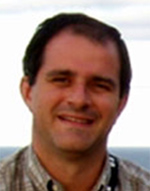 Daniel Segovia-Vargas (M’98) was born in Madrid in 1968. He received the Telecommunication Engineering Degree and the Ph.D. from the Polytechnic University of Madrid in 1993 and in 1998. From 1993 to 1998 he was an Assistant Professor at Valladolid University. From 1998 he is an Associate Professor at Carlos III University in Madrid where he is in charge of the Microwaves and Antenna courses. He has authored and co-authored over 90 technical conference, letters and journal papers. His research areas are printed antennas and active radiators, active arrays and smart antennas, LH metamaterials and passive circuits. He has also been member of the European Projects COST 260, COST 284 and COST IC0603.
Daniel Segovia-Vargas (M’98) was born in Madrid in 1968. He received the Telecommunication Engineering Degree and the Ph.D. from the Polytechnic University of Madrid in 1993 and in 1998. From 1993 to 1998 he was an Assistant Professor at Valladolid University. From 1998 he is an Associate Professor at Carlos III University in Madrid where he is in charge of the Microwaves and Antenna courses. He has authored and co-authored over 90 technical conference, letters and journal papers. His research areas are printed antennas and active radiators, active arrays and smart antennas, LH metamaterials and passive circuits. He has also been member of the European Projects COST 260, COST 284 and COST IC0603.
[1] HERRAIZ-MARTÍNEZ, F.J.; HALL, P.S.; QING LIU; SEGOVIA-VARGAS, D. Left-handed wire antennas over ground plane with wideband tuning. IEEE Transactions on Antennas and Propagation, 2011, vol. 59, no. 5, p. 1460–1471.
[2] GARCÍA-PÉREZ, O.; SEGOVIA-VARGAS, D.; GARCÍA-MUÑOZ, L.E.; JIMÉNEZ-MARTÍN, J.L.; GONZÁLEZ-POSADAS, V. Broadband differential low-noise amplifier for active differential arrays. IEEE Transactions on Microwave Theory and Techniques, 2011, vol. 59, no. 1, p. 108 – 115.
[3] ANDRES-GARCIA, B.; GARCIA-MUNOZ, E.; BAUERSCHMIDT, S.; PREU, S.; MALZER, S.; DOHLER, G.H.; LIJUN WANG; SEGOVIA-VARGAS, D. Gain enhancement by dielectric horns in the terahertz band. IEEE Transactions on Antennas and Propagation, 2011, vol. 59, no. 9, p. 3164 – 3170.
[4] PEREZ, O.G.; GONZALEZ-POSADAS, V.; GARCIA-MUNOZ, L.E.; SEGOVIA-VARGAS, D. Noise-figure measurement of differential amplifiers using nonideal baluns. IEEE Transactions on Microwave Theory and Techniques, 2011, vol. 59, no. 6, p. 1658 – 1664.
[5] GONZALEZ-POSADAS, V.; JIMENEZ-MARTIN, J.L.; PARRA-CERRADA, A.; GARCIA-MUNOZ, L.E.; SEGOVIA-VARGAS, D. Dual-composite right-left-handed transmission lines for the design of compact diplexers. IET Microwaves, Antennas & Propagation, 2010, vol. 4, no. 8, p. 982 – 990.
[6] HERRAIZ-MARTINEZ, F.J.; UGARTE-MUNOZ, E.; GONZALEZ-POSADAS, V.; GARCIA-MUNOZ, L.E.; SEGOVIA-VARGAS, D. Self-diplexed patch antennas based on metamaterials for active RFID systems. IEEE Transactions on Microwave Theory and Techniques, 2009, vol. 57, no. 5, p. 1330 – 1340.
[7] GONZALEZ-POSADAS, V.; JIMENEZ-MARTIN, J.L.; HERRAIZ-MARTINEZ, F.J.; GARCIA-MUNOZ, L.E.; SEGOVIA-VARGAS, D. Design of dual-frequency SRR-loaded dipole with equivalent circuit approach. Electronics Letters, 2009, vol. 45, no. 19, p. 964 – 966.
[8] GARCIA-PEREZ, O.; GARCIA-LAMPEREZ, A.; GONZALEZ-POSADAS, V.; SALAZAR-PALMA, M.; SEGOVIA-VARGAS, D. Dual-band recursive active filters with composite right/left-handed transmission lines. IEEE Transactions on Microwave Theory and Techniques, 2009, vol. 57, no. 5, p. 1180 – 1187.